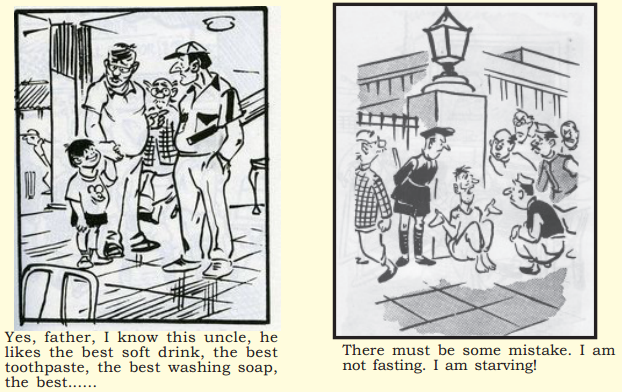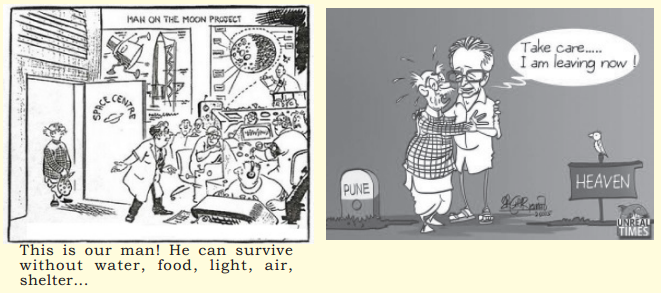Kerala Plus Two English Textbook The Lighter Side Questions and Answers Unit 5
“I love people who make me laugh. I honestly think it’s the thing I like most, to laugh. It cures a multitude of illness. It’s probably the most important thing in a person.”
-Audrey Hepburn
About The Unit
Humour adds to the spice of life. It reduces the boredom of a tension-ridden existence. It makes life easier. If one develops a sense of humour, even unpleasant experiences will become less problematic. It will enhance one’s physical and emotional well being.
Humour has occupied an important place in literature right from the time of Geoffrey Chaucer, the ‘Father of English Literature.’ It is a different mode of depicting reality and it has proved very effective.
This unit has a one-act play, a poem and a short story.
Lets Begin
Look at the cartoons:


Let’S Discuss:
Question 1.
What do you understand from these cartoons? What message do they convey?
Answer:
These cartoons make fun of some of the people and things that we see in everyday life. They are primarily meant to make people smile and laugh. Even as they make us smile, they also make us think. Cartoonists try to bring in changes in the society by making people see how they really look to others. Cartoonists hold a mirrorto the society.
Question 2.
Can you identify the common character in all these cartoons? What is his role? Whom does he represent?
Answer:
The common character is a doctor. His role is to keep the people healthy and happy. He represents somebody working for the welfare of humanity.
Question 3.
Cartoons especially such as those by R.K. Laxman convey the pangs andan3deties of ordinary people. Discuss.
Answer:
The full name of R.K. Laxman is Rasipuram Krishnaswami Iyer Laxman. He was a very famous Indian cartoonist, illustrator, and humorist. He is the brother of R.K. Narayan, who is a great writer, who wrote in English. Laxman is best known for his creation of The Common Man and for his daily cartoon strip, “You Said It” in The Times of India, which started in 1951. In his cartoons he conveyed the pangs and anxieties of ordinary pfeople. He made fun of the political leaders who spent the poor man’s tax money to live in luxury. He sympathized with the common man who was always worried about his ‘roti, kapada and makan’.
Read And Reflect
It is said that laughter is not without an element of pain. Is humour always completely innocent and harmless? Doesn’t it create inconvenience to others at least sometimes? Read the play and see.
